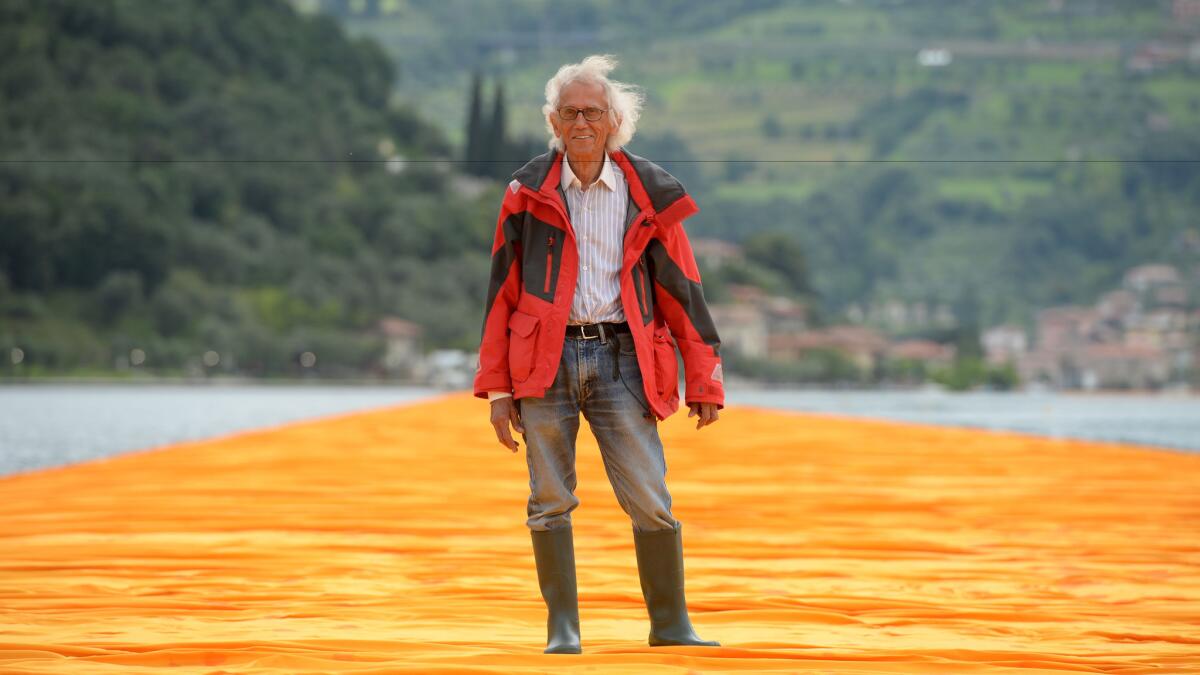Christo, artist known for umbrellas and other large-scale installations, dies

Christo, the artist whose massive environmental public arts projects created in collaboration with his late wife Jeanne-Claude gained global renown, died Sunday at his home in New York City. He was 84.
His death was announced on Twitter and the artist’s website. No cause of death was given.
The husband and wife duo was famous for creating large-scale, temporary environmental art projects since 1961. They used only Christo’s name for decades until 1994 when Jeanne-Claude was added retroactively to many works as his collaborator.
In 2005, he installed more than 7,500 vinyl gates in New York’s Central Park and wrapped the Reichstag in Berlin in fabric with an aluminum sheen in 1995. Their self-financed $26-million “Umbrellas” project erected 1,340 blue umbrellas installed in Japan and 1,760 yellow umbrellas in Southern California in 1991.
The massive, custom-made yellow umbrellas were erected along an 18-mile stretch of the Tejon Pass, about 60 miles north of Los Angeles. The project was marred by tragedy. A Camarillo woman was killed after being hit by one of the 19-foot-tall, 488-pound umbrellas when it blew loose in a windstorm. And in Japan, a crane operator was electrocuted while dismantling a portion of the project there.
The statement on his website said the artist’s next project, “L’Arc de Triomphe, Wrapped,” is slated to appear in September in Paris as planned. An exhibition about Christo and Jeanne-Claude’s work is also scheduled to run from July through October at the Centre Georges Pompidou.
“Christo lived his life to the fullest, not only dreaming up what seemed impossible but realizing it,” his office said in a statement. “Christo and Jeanne-Claude’s artwork brought people together in shared experiences across the globe, and their work lives on in our hearts and memories.”
Born in Bulgaria in 1935, Christo Vladimirov Javacheff studied at the Fine Arts Academy in Sofia before moving to Prague in 1957, then Vienna, then Geneva. It was in Paris in 1958 where he met Jeanne-Claude Denat de Guillebon. They were born on the same day (June 13) in the same year (1935), and, according to him, “In the same moment,” and would become partners in life and art.
Christo was already wrapping smaller found objects, such as cars and furniture. After he met Jeanne-Claude, their scale broadened. Within three years, they were working together on an installation of oil drums and tarp on the docks in Cologne, Germany.
“Our works are temporary in order to endow the works of art with a feeling of urgency to be seen and the love and tenderness brought by the fact that they will not last,” read a 2005 brochure issued by Christo and Jeanne-Claude.
The art of Christo and his late wife, Jeanne-Claude, consists of large, outdoor installations comprising fabric walls, oversize umbrellas, and islands, buildings and coastlines draped or surrounded in fabric.
Although their large-scale outdoor and indoor projects were collaborative, they were all credited solely to Christo until 1994, when they revealed Jeanne-Claude’s contributions. The decision, they said, was theirs and deliberate since it was difficult enough for even one artist to make a name for himself.
The pair moved to New York in 1964, where they liked to say that they were illegal aliens in an illegal building in SoHo for a few years. They eventually bought that building and would call the city home for the rest of their lives.
Jeanne-Claude died in 2009 at age 74 from complications of a brain aneurysm. After her death, Christo said she was argumentative, critical and always asking questions
— and he missed all of that very much.
In a 2018 interview with the Art Newspaper, Christo spoke about his signature wrapping aesthetic. In the instance of the Reichstag, he said, covering it with fabric made the Victorian sculptures, ornament and decoration disappear and “highlight the principal proportion of architecture.”
“But, like classical sculpture, all our wrapped projects are not solid buildings; they are moving with the wind, they are breathing,” he said. “The fabric is very sensual and inviting; it’s like a skin.”
The artists made a point of paying for all of their works on their own and did not accept scholarship or donations.
“I like to be absolutely free, to be totally irrational with no justification for what I like to do,” he said. “I will not give up one centimeter of my freedom for anything.”
“Strolling its fabric-strewn walks gives the imaginative impression of gliding on liquid gold,” wrote The Times’ former art critic William Wilson, describing Christo’s “Pont Neuf” project in 1985. “That agreeable sensation alternates with a muffled sense that the thing sometimes resembles a vast model made of corrugated cardboard and a suspicion that it borders on a bedizened Trump Tower kind of flash.”
The Associated Press contributed to this story.
More to Read
Start your day right
Sign up for Essential California for the L.A. Times biggest news, features and recommendations in your inbox six days a week.
You may occasionally receive promotional content from the Los Angeles Times.







